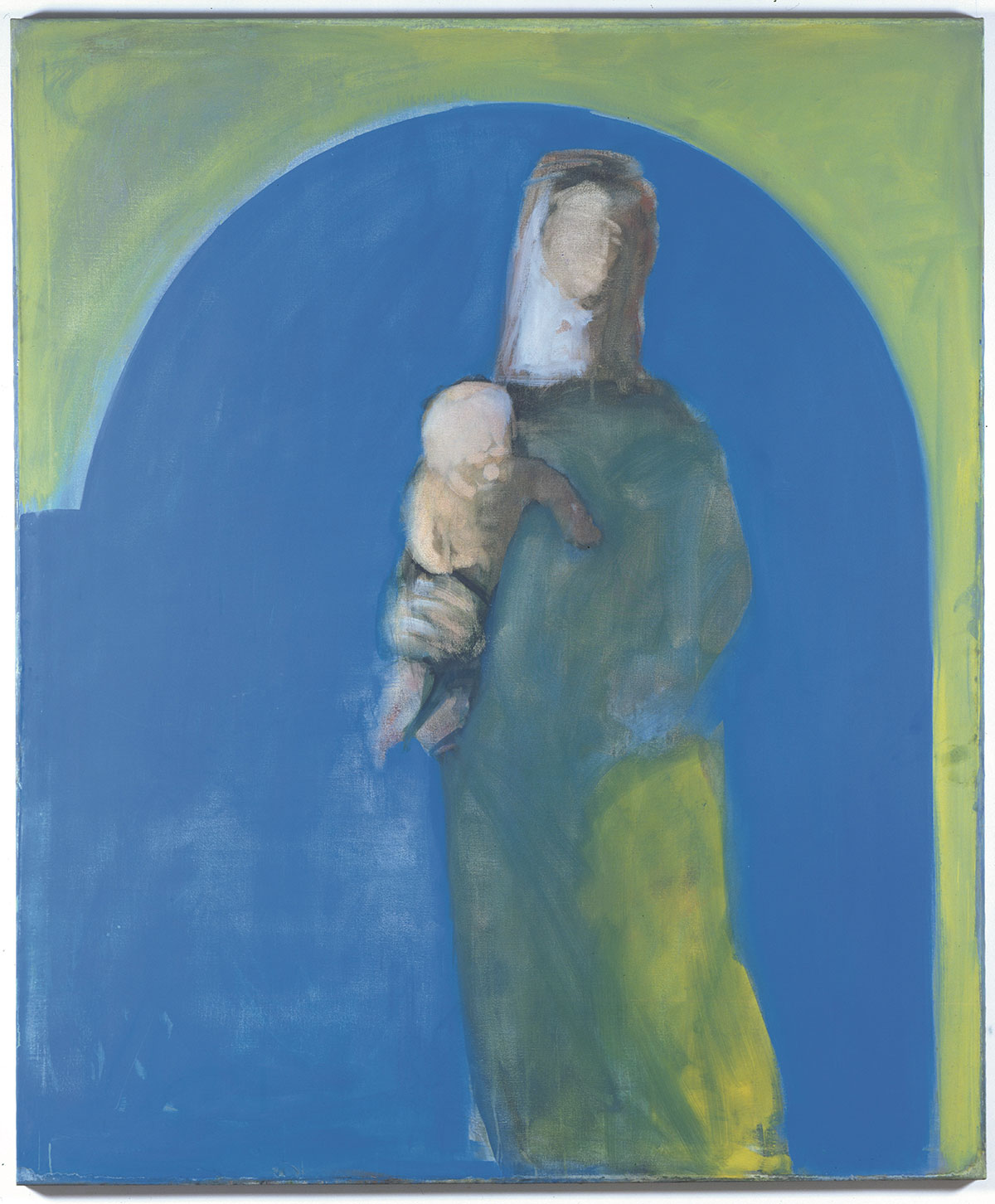The studio belonging to artist Siegfried Anzinger is tucked away inside a back courtyard in Cologne. Small terracotta figures stand guard on concrete blocks. They stare into a room filled with canvasses huddling closely together side by side, paint cans and brushes piled up in the corners. Anzinger, 65 years old, wears a sweater over a button-down shirt with sweatpants. “I draw here each day for four hours and paint for another four hours. In the meantime, I tease my son and watch a bit of TV. That is everyday life, not pathos,” he says laughing.

Siegfried Anzinger in front of a selection of his most recent work.
Siegfried Anzinger participated in documenta in Kassel, was showcased at La Biennale in Venice, and has been a professor of painting at the State Academy of Art in Düsseldorf since 1997. He has acquired loyal followers among art lovers. Prof. Dr. h. c. mult. Reinhold Würth appreciates his work as well: The entrepreneur bought his first piece in 1987 at a gallery in Salzburg. More than 30 years later, some 150 paintings, drawings and sculptures of his can be found in the Würth Collection.

Shiny color pigments as far as the eye can see.
“SOMETHING CALLS OUT INSIDE OF ME: COME ON, BRING ME TO LIFE.”
An exhibition in Museum Würth will be presenting Anzinger’s work until 13 October. The showcase is entitled “A Look Backwards and Forwards”. “I actually don’t like to look back; I was never very interested in retrospectives,” says Anzinger as he hangs a selection of his most recent artwork on the white studio wall in Cologne. But he had a change of heart while preparing the exhibition: “Thanks to Mr. Würth, I was confronted with my past. And in doing so, I was able to reconcile with my old work more than I’d expected,” he says. He will talk later about why he had to make peace with his work from earlier in the first place.
When asked about his past, he first describes his predilection for the arts: “While others were out demonstrating in the 70s, I preferred to visit the museum of art history,” he recalls. A large portion of this passion was instilled in him by his grandmother, who showered him in art books as a child: “When I was six years old, I already knew who Titian was.” He retained his curiosity, studied at the Academy of Fine Arts in Vienna, and moved to Cologne at the start of the 80s. “Originally, I only wanted to leave Vienna for a year, but I stuck around Cologne. A lot happened during that time.”

With over 100 paintings, drawings and sculptures, Museum Würth traces the different phases of the artist’s career.
MUSEUM WÜRTH
The exhibition “Siegfried Anzinger. A Look Backwards and Forwards” will be on display until 13 October 2019.
MUSEUM WÜRTH
Reinhold-Würth-Str. 15
74653 Künzelsau-Gaisbach
Germany
www.kunst.wuerth.com
Opening hours
Daily from 11am – 6pm
Admission free
Wheelchair accessible
One of the reasons why Anzinger feels at home in Rhineland to this day has to do with his transformation as an artist: “In Austria, expressionism is held in high esteem. Here I get a break from that.” While his older works were expressive and gestural, his more recent pieces are considerably more reserved. “Exaggerated gestures were a sign of fear – like someone singing loudly in the forest to keep from hearing the sinister noises. But after a while, the noises become absurd,” he says.
When looking at his current work, the diverse selection of motifs catches the eye: wild animals, landscapes, Native Americans, erotic illustrations. However, the artist is more interested in transmitting an artistic idea than the subject itself: “One must not overpower the art of painting with an extravagant motif.” His own creative process is reflected in this attitude. In order to achieve his objective, he has to avoid being single-minded: “If I am able to put aside my ego, as if the hand of a stranger were painting, the chances of getting a good result are higher.” For Anzinger, this is all about self-discovery. “I surrender myself to the painting process in order to find out what my subconscious has in store for me.” He therefore serves as his own source of inspiration. “Something calls out inside of me: Come on, bring me to life.”
SIEGFRIED ANZINGER’S PARTICIPATION IN DOCUMENTA 7 IN KASSEL IS WHAT MADE HIM FAMOUS IN 1982.
Anzinger describes himself as a fast painter: He needs two days at most to finish a painting, usually just a few hours even. Nevertheless, countless discarded drafts lay crumpled up below each of his finished pieces. “I wash the paint off the canvas over and over, and paint the motif anew.” He refers to his finished work as “the sum of all revisions.” Even in this regard, he has changed, although in this case his age is to blame. “When you’re 25 years old, you can run up and down the mountain five times,” he says, “but when you no longer have the stamina, you have to be smarter to reach the top in the same amount of time. “I can’t afford to turn down a thousand different dead ends anymore.” Anzinger has figured out how to avoid making wrong turns: “The picture tells me when there’s no going back. That’s when it’s finished.”
It seems there is a message behind Siegfried Anzinger’s art after all: His art is the art of letting go.





















